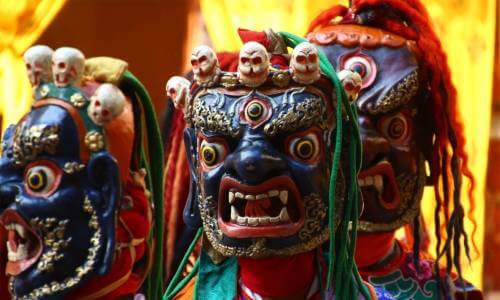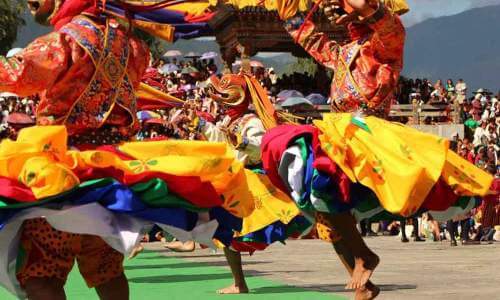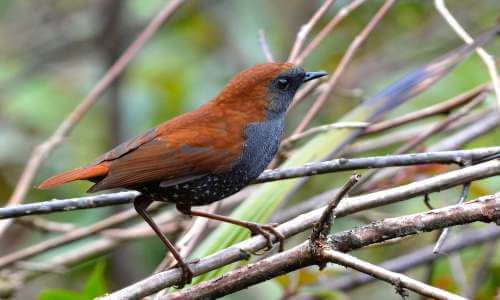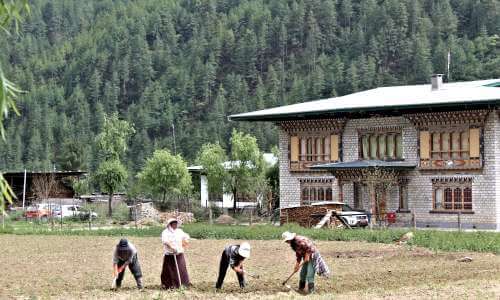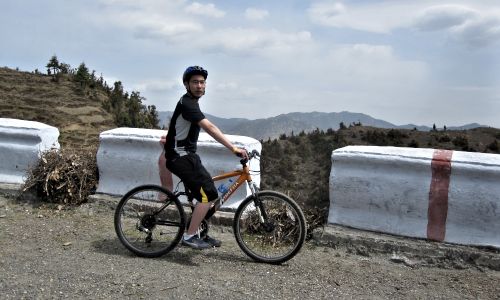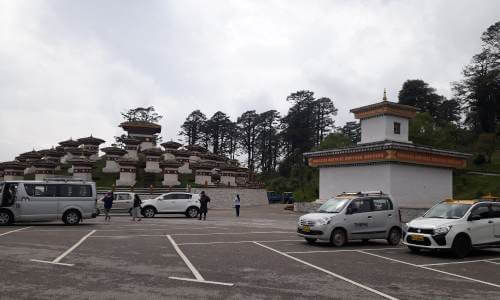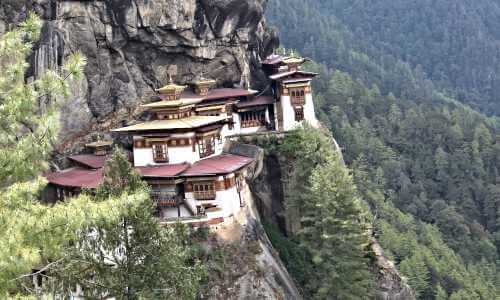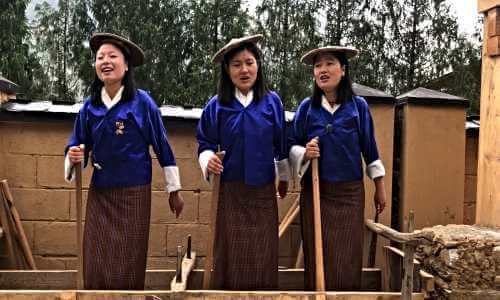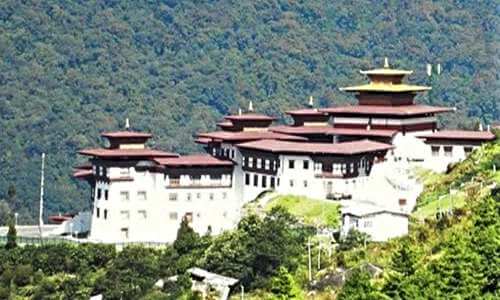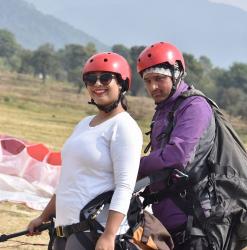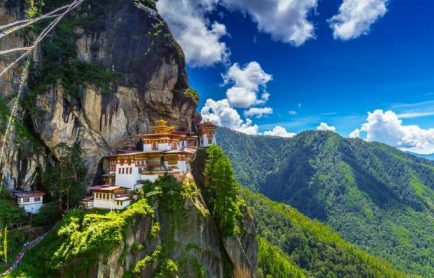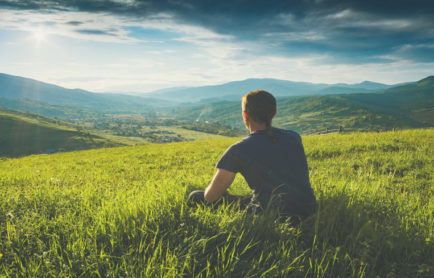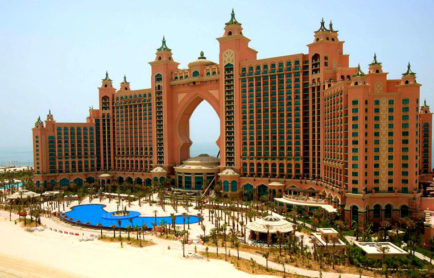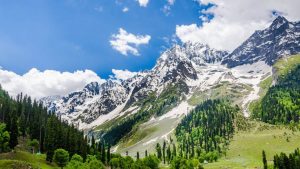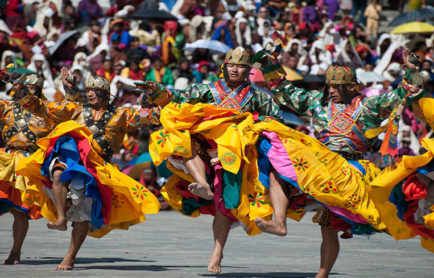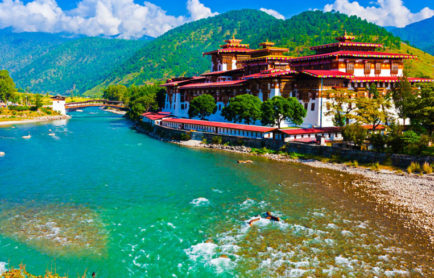How to Plan a Perfect Punakha Valley Trip in Bhutan?
 Published: 15 Jan, 2020By Nidhi Singh
Published: 15 Jan, 2020By Nidhi Singh
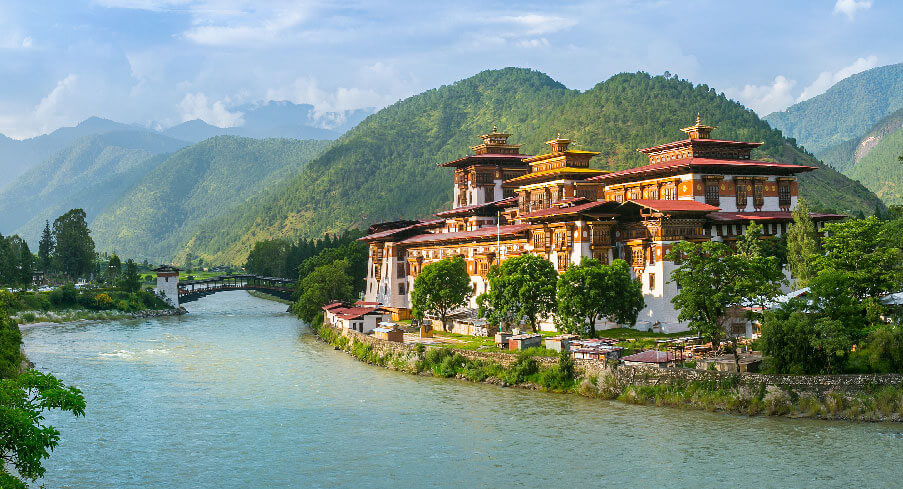
Here, we offer you an insightful guide into how to plan your trip to Punakha from India and abroad. You will get all the travel tips and things you need to know before visiting Punakha for a memorable trip, in this article. Punakha is a beautiful city in the dramatic country of Bhutan. This travel guide has answers to all your questions regarding what to do in Punakha. For the best healthy travelling tips for Bhutan, read this article.
About Punakha
Punakha is a small beautiful town in the valleys of Himalaya mountain ranges. It is located on the banks of two beautiful rivers – Pho and Mo Chhu. At one point in time, Punakha was the centre and capital of Bhutan. It is also home to the most sacred relic of Bhutan – Rang Jung Kharsapani. More on that later.
Punakha is easily the most beautiful destination in Bhutan, and one of the must-visit destinations in Asia. This is a place that you must visit to experience the best natural landscapes and the old Buddhist architecture of Bhutan. There are also some shopping places in Punakha where you may want to get some souvenirs.
Recommended Tours
Few Interesting Facts You Must Know about Punakha Before Traveling
- Before Thimphu was the capital of Bhutan, Punakha served as its capital until 1955.
- Punakha Dzong is associated with a famous legend, according to which, Sage Padmasambhava prophesied that “a person named Namgyal will arrive at a hill that looks like an elephant”. True enough, Ngawang Namgyal, 1st Zhabdrung Rinpoche, came across the peak of the hill which resembled the trunk of an elephant. He built the dzong in 1637-38.
- Punakha is known as the rice bowl of Bhutan, since it produces a major part of the rice in Bhutan, along with red and white rice.
- Chimi Lhakhang, which means the Fertility Temple, is a Buddhist monastery built by Ngawang Choegyel, the 14th Drukpa hierarch, over half a millennium ago. It is famous as a fertility inducing magnet, and is visited by a large number of couples wishing to conceive.
- Punakha suspension bridge is one of the most visited places in Bhutan. Spanning almost 1860-180 meters in length, it is located at a very impressive height above the River Po Chu.
- The most popular festival of Punakha is Punakha Tshechu. The highlight of the festival is the unfurling of thongdrol, which is a large tapestry of Guru Rinpoche.
How to reach Punakha?
By Air: If you are travelling by air, the best way to reach Punakha is by flying to Paro. From Paro in Bhutan, Punakha is just 120 km away. You can take the most scenic bus ride and reach Punakha.
Alternatively, if you are travelling from India, you can fly to the nearest airport in India – Bagdogra. Then take a train or bus journey into Bhutan.
By Train or Roads from India: You can enter Bhutan by road from the Jaigaon in West Bengal, which is situated on the Indo-Bhutan borders. Hasimara is the nearest railway station to Jaigaon.
How to get a visa or a tourist permit in Bhutan?
Bhutan Tourism Board has a policy of “High-Value Low Impact” tourism. Only a limited number of people are allowed to enter Bhutan. Citizens from India, Bangladesh and Maldives can obtain tourist permit in Bhutan on arrival. Under certain treaties and agreements, there are no charges for Visa for citizens of India, Bangladesh and the Maldives.
List of documents for on arrival Visa for citizens of India, Bangladesh and Maldives:
- A duly filled form for tourist permit in Bhutan.
- Your Itinerary on an A4 Sheet.
- A passport that is valid for at least six months (Indians also have the option of showing their Voter’s ID card).
- Your Passport Size Photo.
- Booked Hotel’s Voucher (It is compulsory to show booking confirmation of at least one hotel in Thimphu/Paro).
- An Undertaking Letter (If you are travelling alone).
Online permit system for tourists from India, Bangladesh & the Maldives
Tourists from India, Bangladesh & the Maldives can also obtain their permit clearances and route permits online. The Online Permit System enables the online processing of permits for tourists from the above mentioned countries through registered Bhutanese tour operators. However, it should be kept in mind that this facility is only applicable for entry from Paro and Phuentsholing.
Travel Requirements for International tourists, or those outside India, Bangladesh & the Maldives
Tourists who are not from the countries of India, Bangladesh and the Maldives have to obtain a visa clearance before travelling to Bhutan. The visa applications are processed either through an online system by a licenced Bhutanese tour operator or directly through a foreign travel agent.
Process for acquiring the visa
Tourists are required to send a photocopy of their passport to their tour operator, who will then apply for the visa. Tourism Council of Bhutan (TCB) will process the visa after the full payment (USD40) has been wire transferred, and received in the TCB bank account. After the payment is received, it takes 72 hours for the visa clearance process.
Upon entering Bhutan, tourists will be required to show their visa clearance letter, after which the visa will be stamped into the passport.
International tourists have to take the minimum daily package
International tourists, or those not belonging to India, Bangladesh and the Maldives, have to take a Minimum Daily Package. The package covers the following services:
- 3-star accommodation minimum (4&5 star may require additional premium).
- All meals included.
- A licenced Bhutanese tour guide to accompany you throughout the duration of your stay.
- All transport within the country (excluding internal flights).
- Camping equipment and haulage required for trekking tours.
Minimum daily package fees
- USD $200 per person per night for January, February, June, July, August and December.
- USD $250 per person per night for the months of March, April, May, September, October and November.
Restricted areas permit
The normal tourist permit in Bhutan provides entry to Punakha, Thimphu and Paro only. If you wish to enter into other areas, then you must obtain restricted areas permit. If you want to enter the Bhutanese temples, then you must obtain the Bhutan temples permit too. The restricted areas permit is generally issued for 7 to 14 days to all the foreigners.
- Some Important points: Make sure to reach early to avoid long queues of people travelling to Bhutan. If you forget to get copies of your documents, there are shops near the immigration office where you can get the photocopies.
Where to stay in Punakha?
There are various hotels and resorts in Punakha where you can plan your stay. Depending on your budget, you may book a hotel from $20 to even $150 (or €20 to €125). A basic stay with all the amenities are available from $20 to $35 (or €20 to €30). The rates may vary as per the seasons of tourism.
When looking for budget accommodations in Punakha, look for a good hotel/resort if you love your night’s sleep. Several cheap places may not be worth your money, as they lack the most basic amenities.
Best Tourism Places to Visit in Punakha
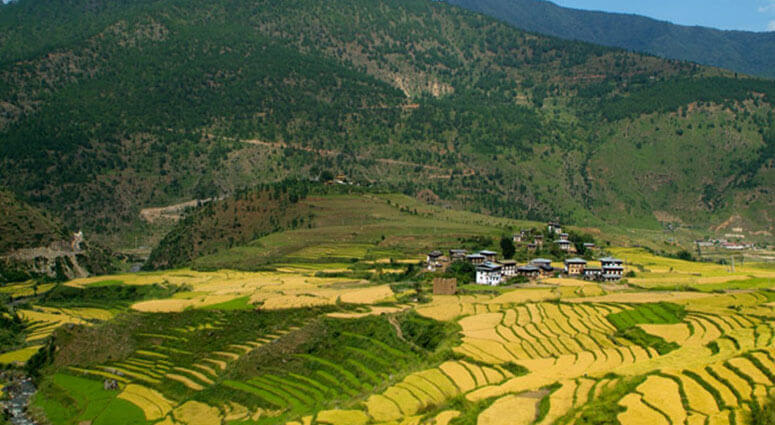
Below are the top things to do that will make you fall head over heels for Punakha, not quite literally!
Punakha Dzong: One of the main reasons to visit Punakha in Bhutan is the Punakha Dzong. It is built at the convergence of the two rivers of Punakha – Pho and Mo Chhu. The architecture is very ancient, as it is the second oldest Dzong after Simtokha Dzong. Punakha Dzong is the most majestic Dzong and also the second-largest in Bhutan. Today it is the administrative building of Punakha district. In spring, it is even more beautiful, as the jacaranda trees around it are full of lilac-coloured flowers.
Chimi Lhakhang: Chimi Lhakhang is a Buddhist monastery or temple in Bhutan. It is widely known as the fertility temple of Bhutan. It is said that any childless couple who pays a visit is granted with a baby. The temple is dedicated to Lama Drukpa Kunley, the 15th-century Tibetan magician, saint and exponent of ‘crazy wisdom.’ Chimi Lhakhang is also a place where Phalluses are worn as charms. It is one of those tourist attractions in Punakha that you must visit when visiting Punakha.
Khamsum Yulley Namgyal Chorten: Khamsum Yulley Namgyal Chorten was built in 2004 by the Queen Mother. It is a classic example of the beautiful traditions of the country. You can reach here after a scenic hike of around 45 minutes. Khamsum Yulley Namgyal Chorten is situated on a ridge above the Punakha valley. The view down below is very very pretty. This Chorten is one of the best places to visit in Bhutan.
Talo: Talo is another beautiful monastery in Punakha. It is located in the hills above Punakha. Your sightseeing in Punakha is not complete without a visit to Talo. It is located atop a plateau and there is a picturesque hamlet nearby. It is called the village of Talo. If you are visiting it in March, you must participate in the Talo Tshechu. This is a three-four day festival in Talo and Paro of Bhutan. You can dance along with the beautiful locals dressed in their clothes, or just enjoy the dancing skills and art.
Punakha Ritsha Village: Bhutan is known for organic farming, and you can observe it in this beautiful village in Punakha. Rice cultivation is most common in Ritsha Village. Along the rivers Pho and Mo Chhu, there are many fertile lands where both red and white rice are grown. Punakha Ritsha Village is extremely beautiful, with various square fields all over the landscape.
Other tourism activities in Punakha
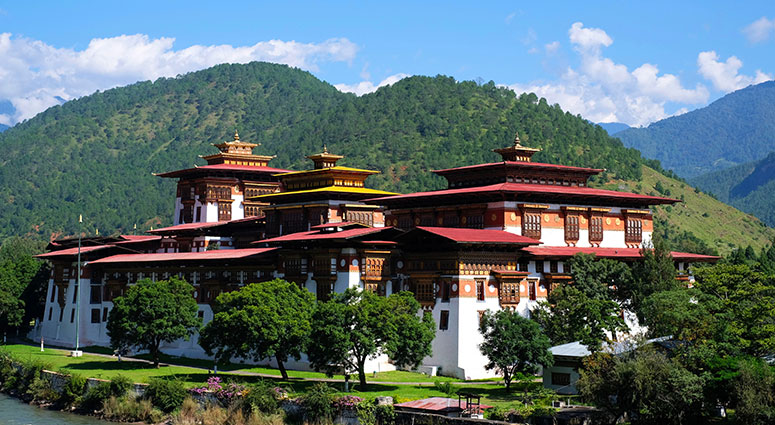
White water rafting in River Mo Chhu: If you wish to add some adventure to your vacation in Bhutan, you can opt for river rafting on the beautiful River Mo Chhu.
Punakha Suspension Bridge: Walk across the stunning Punakha Suspension Bridge. Beautiful rivers and gorges are all over Bhutan as well as the suspension bridges. The Punakha suspension Bridge takes you on a thrilling 160 meters or 15-minute walk over the waters of River Mo Chhu.
Rangjung Kharsapani: Rangjung Kharsapani is the most sacred relic and a treasure of Bhutan. The story is that Tsangpa Gyarey was a human manifestation form of Avalokiteshvara – Buddhist God. On his death, when he was being cremated, rainbows appeared in the sky and flowers poured down. His heart, tongue and eyes remained intact. Twenty-one joints of his backbone turned into twenty-one statues. To this day, these are well preserved. You can visit this place in Punakha and ask for a blessing. If you pray here, it is said that all the wrong deeds will be purified and your dreams will be fulfilled.
Dochula Pass: This is the most scenic route in Bhutan from Thimphu to Punakha. Dochula Pass gives magnificent views of the valleys and the Himalayan Mountains. You can drive here if you are seeking that adrenaline rush. Alternatively, take the local transport that is a bus or a private vehicle. The views throughout the Dochula Pass are astounding. Another notable feature is the 108 Druk Wangyal Chortens which were built by the Queen Mother.
Jigme Dorji National Park: Jigme Dorji National Park is named after the late Jigme Dorji Wangchuck. It covers most of the area of Gasa district, as well as areas from Thimphu, Paro and Punakha district too. This is the second-largest park in Bhutan. Many species of birds can be found here. Among the animals, you can spot the red panda, blue sheep, snow bear and Bengal Tiger. The endangered species of Himalayan Black bear can also be found if you are in luck.
Currency in Punakha, Bhutan
The Bhutanese use a currency called “Ngultrum”. $1 is equal to around 70 Ng. And €1 is equal to around 80 Ng. For Indians, the INR is equal to Ng. And the Indian currency of INR 5, 10, 20, 50, and 100, are widely used in Bhutan. The Bhutanese do not accept the Indian currency of INR 2000 and INR 500.
Best time to visit Punakha
Punakha or Bhutan, in general, has four seasons. Each of the seasons, from spring to winter, has its own beauty.
- Spring, that is from March to May is the best time to plan your holidays in Punakha. This is because of the beautiful blossoms of trees like jacaranda, which can be seen throughout the valley. The weather is perfect and the climate enjoyable. The average highest temperature is 26 degrees Celsius, and the lowest is 5 degrees Celsius.
- Summer, that is from June to August, is the time when Punakha receives rainfall. The glorious skies and the warm weather is a beautiful time to visit Punakha. The temperature is around 27–28 degree Celsius.
- Autumn, which lasts from September to November, is the time when Bhutan receives perfect mild autumn weather. Various festivals are held in early September or late October. The temperatures range from 26-18 degree Celsius.
- Winter, which lasts from December to February, sees Punakha transformed into a perfect winter wonderland. It does not snow or rain heavily, while the temperatures vary from 16 – 5 degree Celsius.
Planning a perfect trip to Punakha is not all that difficult. This blog will go a long way in helping you plan such a trip without many hassles. Let us know how helpful this blog was the next time you visit this lovely destination in Bhutan.
Popular Post
Category by Destinations
Travel Intel
Category by Continent
India recent post
Enquiry Form
Get Customized Travel Quotes from Tour My India
